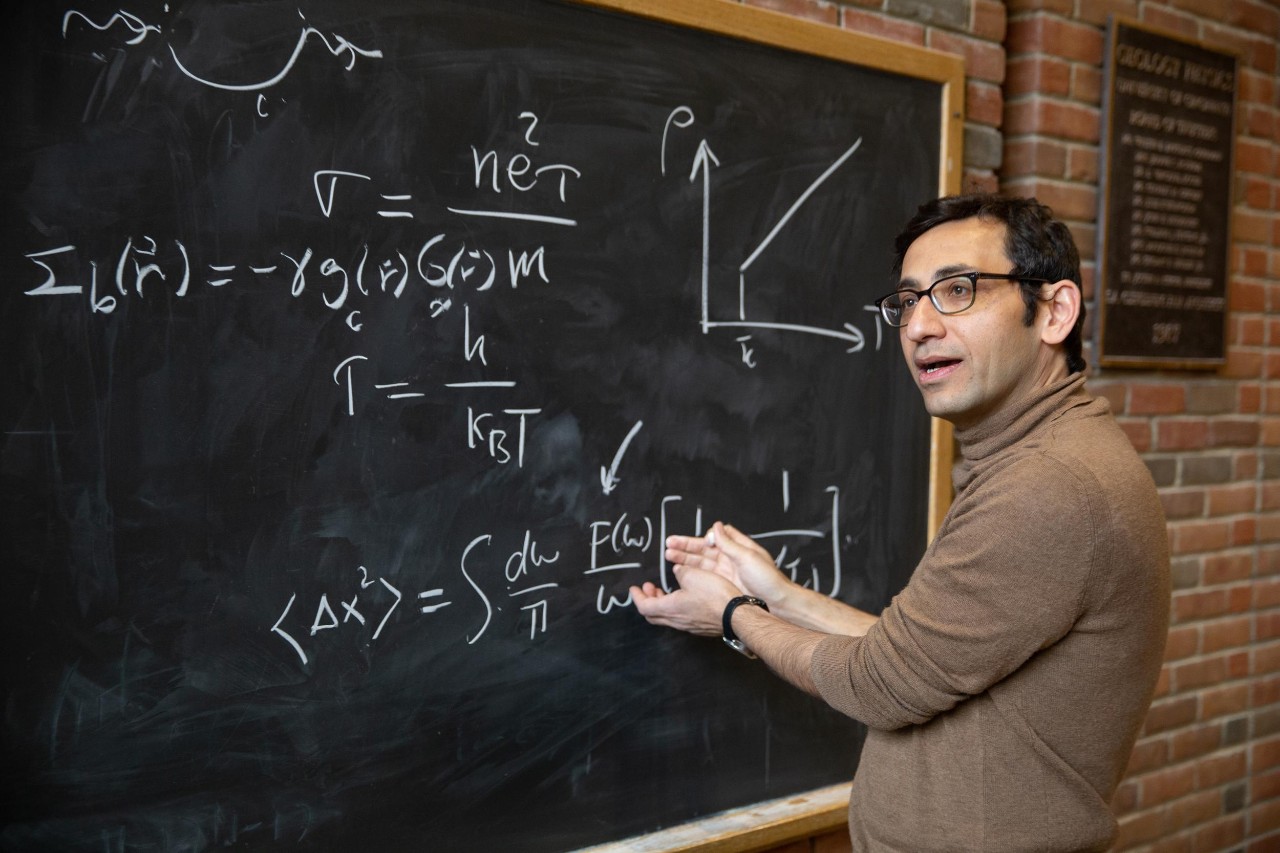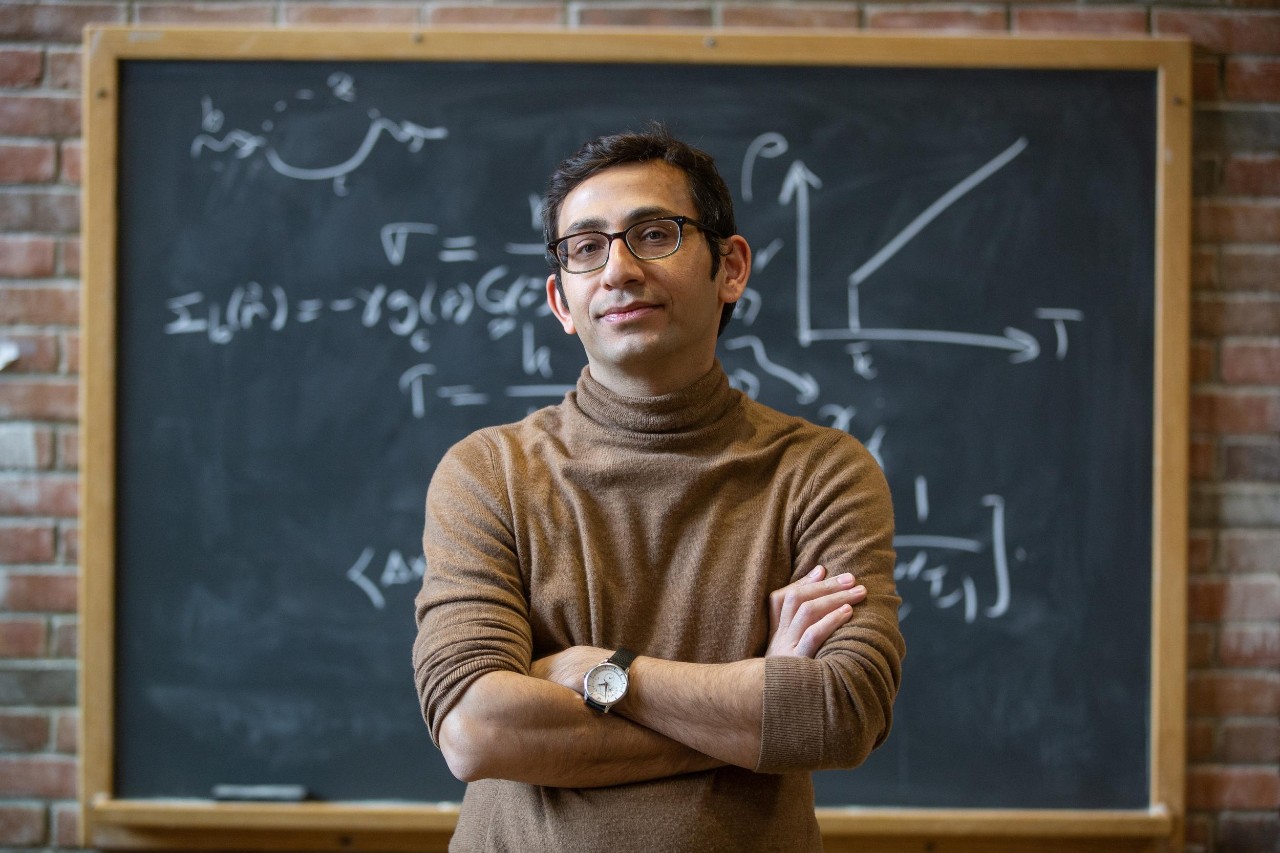
UC physicist explores mysteries of strange metals
International team finds unusual electrical behavior in experiments
Physicists at the University of Cincinnati are learning more about the bizarre behavior of “strange metals,” which operate outside the normal rules of electricity.
Theoretical physicist Yashar Komijani, an assistant professor in UC’s College of Arts and Sciences, contributed to an international experiment using a strange metal made from an alloy of ytterbium, a rare earth metal. Physicists in a lab in Hyogo, Japan, fired radioactive gamma rays at the strange metal to observe its unusual electrical behavior.
Led by Hisao Kobayashi with the University of Hyogo and RIKEN, the study was published in the journal Science. The experiment revealed unusual fluctuations in the strange metal’s electrical charge.
“The idea is that in a metal, you have a sea of electrons moving in the background on a lattice of ions,” Komijani said. “But a marvelous thing happens with quantum mechanics. You can forget about the complications of the lattice of ions. Instead, they behave as if they are in a vacuum.”

UC Assistant Professor Yashar Komijani worked with an international team of experimental and theoretical physicists to explore strange metals. Photo/Andrew Higley/UC Marketing + Brand
Komijani for years has been exploring the mysteries of strange metals in relation to quantum mechanics.
“You can put something in a black box and I can tell you a lot about what’s inside it without even looking at it just by measuring things like resistivity, heat capacity and conductivity,” he said.
“But when it comes to strange metals, I have no idea why they are showing the behavior they do. The mystery is why does the charge fluctuate so slowly in a strongly correlated quantum system?”
The mystery is why does the charge fluctuate so slowly in a strongly correlated quantum system?
Yashar Komijani, UC theoretical physicist
Strange metals are of interest to a wide range of physicists studying everything from particle physics to quantum mechanics. One reason is because of their oddly high conductivity, at least under extremely cold temperatures, which gives them potential as superconductors for quantum computing.
“The thing that is really exciting about these new results is that they provide a new insight into the inner machinery of the strange metal,” said study co-author Piers Coleman, a distinguished professor at Rutgers University.
“These metals provide the canvas for new forms of electronic matter — especially exotic and high temperature superconductivity,” he said.
Coleman said it’s too soon to speculate about what new technologies strange metals might inspire.
“It is said that after Michael Faraday discovered electromagnetism, the British Chancellor William Gladstone asked what it would be good for,” Coleman said. “Faraday answered that while he didn't know, he was sure that one day the government would tax it.”
Faraday’s discoveries opened a world of innovation.
“We feel a bit the same about the strange metal,” Coleman said. “Metals play such a central role today — copper, the archetypal conventional metal, is in all devices, all power lines, all around us.”
Coleman said strange metals one day could be just as ubiquitous in our technology.
“The big question about strange metals - is the origin of their scale invariance — their ‘quantum criticality,’” he said. “While the experimentalists are going to try to replicate our results on other strange metals, our team at UC and Rutgers will try to fold our new discovery into a new theory of the strange metals.”
The experiment was groundbreaking in part because of the way that researchers created the gamma particles using a particle accelerator called a synchrotron.
“In Japan, they use a synchrotron like they have at CERN [the European Organization for Nuclear Research] that accelerates a proton and smashes it into a wall and it emits a gamma ray,” Komijani said. “So they have an on-demand source of gamma rays without using radioactive material.”
Researchers used spectroscopy to study the effects of gamma rays on the strange metal.
Researchers also examined the speed of the metal’s electrical charge fluctuations, which take just a nanosecond — a billionth of a second. That might seem incredibly fast, Komijani said.
“However, in the quantum world, a nanosecond is an eternity,” he said. “For a long time we have been wondering why these fluctuations are actually so slow. We came up with a theory with collaborators that there might be vibrations of the lattice and indeed that was the case.”
The study was funded in part by the National Science Foundation and the Department of Energy.
Featured image at top: UC theoretical physicist Yashar Komijani is studying the properties of strange metals. Photo/Andrew Higley/UC Marketing + Brand
Next Lives Here
The University of Cincinnati is classified as a Research 1 institution by the Carnegie Commission and is ranked in the National Science Foundation's Top-35 public research universities. UC's graduate students and faculty investigate problems and innovate solutions with real-world impact. Next Lives Here.
Related Stories
Cincinnati researchers want to know if MRIs can work better
June 28, 2024
WVXU and the Cincinnati Business Courier highlighted a new collaboration between the University of Cincinnati College of Medicine, UC Health GE HealthCare, JobsOhio, REDI Cincinnati and Cincinnati Children’s to create an MRI Research and Development Center of Excellence located on UC’s medical campus.
UC 1819 Innovation Hub workshop spreads AI awareness
June 28, 2024
Microsoft and Disrupt Now joined forces to run a June 24-27 seminar at UC’s 1819 Innovation Hub teaching Cincinnati residents how to responsibly use AI.
Free Wi-Fi, work area coming to Greater Cincinnati
June 27, 2024
St. Lawrence Park in Price Hill now has free Wi-Fi and a furnished outdoor space for community members to access digital needs. The space is part of The Nodes Project, which stands for “Neighborhoods of Design Engagement": a collaboration between UC DAAP communication designers and community entities.
Study aimed at reducing opioid overdose deaths presents results
June 27, 2024
The University of Cincinnati's John Winhusen and Caroline Freiermuth discussed the evidence-based practices implemented during the HEALing Communities Study to fight the opioid epidemic with Spectrum News.
UC alum credits journalism program with early success
June 26, 2024
Zachary Jarrell came to the University of Cincinnati in 2019 to pursue a degree in statistics. In 2023, he graduated with a Bachelor’s in Journalism. For many undergraduates, the journey through college rarely takes the expected track. Detours happen, and majors change. When plans switch up, it can be helpful to a student’s success to find support. For Jarrell, it was the people he worked alongside in the journalism department who helped him on his journey. It has left a lasting impression on his life so far, guiding him to multiple internships as an undergraduate, real-world experience in prominent news outlets, and eventually a successful career in the highly competitive field of journalism.
University of Cincinnati, UC Health collaborate with GE HealthCare on MRI research center
June 26, 2024
The University of Cincinnati and UC Health are collaborating with GE HealthCare, JobsOhio, REDI Cincinnati and Cincinnati Children’s to create an MRI Research and Development Center of Excellence located on UC’s medical campus.
The health impact of living near a natural gas leak
June 25, 2024
UC College of Arts and Sciences Professor Amy Townsend-Small talks to the BBC about the health issues faced by neighbors of leaking natural gas wells.
University of Cincinnati Cancer Center launches Blood Cancer Healing Center
June 25, 2024
The University of Cincinnati Cancer Center celebrated the opening of its state-of-the-art Blood Cancer Healing Center June 24.
Carnegie Foundation recognizes UC with Leadership for Public Purpose classification
June 24, 2024
UC part of inaugural group honored for focusing on developing students as leaders
UC study: Signaling pathway in brain helps maintain health, prevent cognitive deficit
June 24, 2024
Research led by the University of Cincinnati sheds new light on the role of the TGF-β signaling pathway in the brain to maintain balance and prevent inflammation and cognitive deficits.
